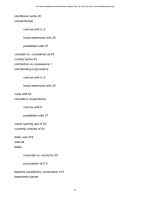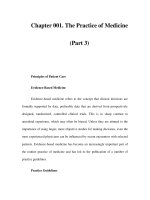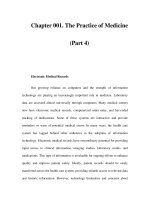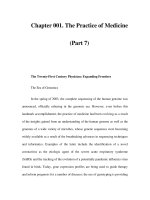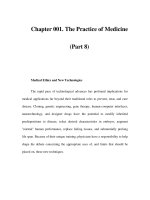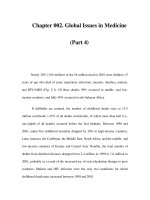Chapter 001. The Practice of Medicine (Part 7) docx
Bạn đang xem bản rút gọn của tài liệu. Xem và tải ngay bản đầy đủ của tài liệu tại đây (15.44 KB, 5 trang )
Chapter 001. The Practice of Medicine
(Part 7)
The Twenty-First Century Physician: Expanding Frontiers
The Era of Genomics
In the spring of 2003, the complete sequencing of the human genome was
announced, officially ushering in the genomic era. However, even before this
landmark accomplishment, the practice of medicine had been evolving as a result
of the insights gained from an understanding of the human genome as well as the
genomes of a wide variety of microbes, whose genetic sequences were becoming
widely available as a result of the breathtaking advances in sequencing techniques
and informatics. Examples of the latter include the identification of a novel
coronavirus as the etiologic agent of the severe acute respiratory syndrome
(SARS) and the tracking of the evolution of a potentially pandemic influenza virus
found in birds. Today, gene expression profiles are being used to guide therapy
and inform prognosis for a number of diseases; the use of genotyping is providing
a new means to assess the risk of certain diseases as well as variation in response
to a number of drugs; we are understanding better the role of certain genes in the
causality of certain common conditions such as obesity and allergies. Despite
these advances, we are still in the infancy of understanding and utilizing the
complexities of genomics in the diagnosis, prevention, and treatment of disease.
Our task is complicated by the fact that phenotypes are generally determined not
by genes alone but by the interplay of genetic and environmental factors. Indeed,
we have just begun to scratch the surface of possibilities that the era of genomics
will provide to the practice of medicine.
The rapidity of these advances may seem overwhelming to the practicing
physician. However, he or she has an important role to play in ensuring that these
powerful technologies and sources of new information are applied with sensitivity
and intelligence to the patient. Since genomics is such a rapidly evolving field,
physicians and other health care professionals must continue to educate
themselves so that they can apply this new knowledge to the benefit of their
patients' health and well-being. Genetic testing requires wise counsel based on an
understanding of the value and limitations of the tests as well as the implications
of their results for specific individuals. For a more complete discussion of genetic
testing, see Chap. 64.
The Globalization of Medicine
Physicians should be cognizant of diseases and health care services beyond
local boundaries. Global travel has implications for disease spread, and it is not
uncommon for diseases endemic to certain regions to be seen in other regions after
a patient has traveled and returned from these regions. Patients have broader
access to unique expertise or clinical trials at distant medical centers, and the cost
of travel may be offset by the quality of care at these distant locations. As much as
any other factor influencing global aspects of medicine, the Internet has
transformed the transfer of medical information throughout the world. This change
has been accompanied by the transfer of technological skills through telemedicine
and international consultation for radiologic images and pathologic specimens. For
a complete discussion of global issues, see Chap. 2.
Medicine on the Internet
On the whole, the Internet has had a very positive effect on the practice of
medicine; a wide range of information is available to physicians and patients
through personal computers almost instantaneously at any time and from
anywhere in the world. This medium holds enormous potential for delivering up-
to-date information, practice guidelines, state-of-the-art conferences, journal
contents, textbooks (including this text), and direct communications with other
physicians and specialists, thereby expanding the depth and breadth of information
available to the physician about the diagnosis and care of patients. Most medical
journals are now accessible online, providing rapid and comprehensive sources of
information. This medium also serves to lessen the information gap felt by
physicians and health care providers in remote areas of the world by bringing them
into direct and instant contact with the latest developments in medical care.
Patients, too, are turning to the Internet in increasing numbers to acquire
information about their illnesses and therapies and to join Internet-based support
groups. Physicians are increasingly faced with the prospect of dealing with
patients who arrive with sophisticated information about their illness. In this
regard, physicians are challenged in a positive way to keep themselves abreast of
the latest relevant information while serving as an "editor" for the patients as they
navigate through this seemingly endless source of information.
A critically important caveat is that virtually anything can be published on
the Internet, with easy circumvention of the peer-review process that is an
essential feature of quality publications. Physicians or patients who search the
Internet for medical information must be aware of this danger. Notwithstanding
this limitation, appropriate use of the Internet is revolutionizing information access
for physicians and patients and in this regard is a great benefit that was not
available to our predecessors.
Public Expectations and Accountability
The level of knowledge and sophistication regarding health issues on the
part of the general public has grown rapidly over the past few decades. As a result,
expectations of the health care system in general and of physicians in particular
have risen. Physicians are expected to master rapidly advancing fields (the science
of medicine) while considering their patients' unique needs (the art of medicine).
Thus, physicians are held accountable not only for the technical aspects of the care
that they provide but also for their patients' satisfaction with the delivery and costs
of care.
In many parts of the world, physicians are increasingly expected to account
for the way in which they practice medicine by meeting certain standards
prescribed by federal and local governments. The hospitalization of patients whose
health care costs are reimbursed by the government and other third parties is
subjected to utilization review. Thus, the physician must defend the cause for and
duration of a patient's hospitalization if it falls outside certain "average" standards.
Authorization for reimbursement is increasingly based on documentation of the
nature and complexity of an illness, as reflected by recorded elements of the
history and physical examination. There is a growing "pay for performance"
movement, which seeks to link reimbursement to quality of care. The goal of this
movement is to improve standards of health care and to contain spiraling health
care costs. Physicians are also expected to give evidence of their continuing
competence through mandatory continuing education, patient-record audits,
maintenance of certification, or relicensing.
